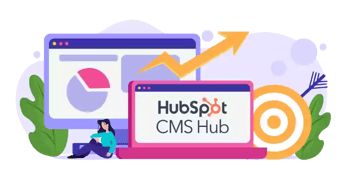Are You Getting the Most Value From Your HubSpot Subscription? The HubSpot Admin Accelerator program is designed to optimize your HubSpot investment.
How We Use HubSpot Content Hub for SEO
In today's digital landscape, SEO and Content Marketing reign supreme, but navigating its intricacies can be daunting. We've explored various tools and strategies and found a new favorite in our book—HubSpot Content Hub.
With its versatile toolkit and automation capabilities, HubSpot makes mastering SEO and the associated content creation more effortless than ever. Here's how we use it.
HubSpot Content Hub users:
-
Have a 23% higher chance of ranking on the first page of Google for their target keywords.
-
See a 43% increase in organic traffic on average within six months
-
Rank for 27% more keywords on average within six months.
Using HubSpot Content Hub for SEO
As a growing business, we understand the value of an intelligent investment. HubSpot Content Hub offered us an affordable yet robust platform aligned perfectly with a Startup budget. Unlike some SEO tools with steep price tags, the platform provides a cost-effective solution without compromising core features and functionalities.
Plus, HubSpot Content Hub is more than just an SEO tool; it's an all-in-one inbound marketing platform. This holistic approach was crucial because it allowed us to consolidate various marketing efforts, including email marketing, content creation, and social media management, under a single roof. This consolidation not only saved us time but also ensured better collaboration among our marketing teams.
One of the key factors that swayed our decision in favor of HubSpot was its user-friendly interface. Unlike some SEO tools that can be intimidating for beginners, HubSpot's intuitive design made it easy for our team to adapt and utilize the platform effectively. This reduced the learning curve and allowed us to start our SEO efforts promptly.
Keyword Research and Analysis
HubSpot's comprehensive keyword research tools provide valuable insights into our target audience's search behavior. We can identify high-value keywords, long-tail phrases, and trends, allowing us to tailor our content to meet our audience's specific needs and interests.
How to find: To access HubSpot's keyword research and analysis tools, log into your HubSpot account.
-
From your HubSpot dashboard, navigate to the "Marketing" tab in the top menu.
-
In the Marketing dashboard, select "SEO" from the left-hand sidebar.
-
Within the SEO dashboard, you'll find the "Keywords" section. Here, you can explore keyword suggestions, analyze keyword performance, and track keyword rankings.
-
To conduct more in-depth keyword research, click "Research" under the "Keywords" section. This will allow you to discover relevant keywords and assess their search volume, difficulty, and potential impact on your SEO efforts.
Content Optimization Tools
Crafting SEO-friendly content is a cornerstone of successful digital marketing. HubSpot equips us with tools that analyze our content in real time, providing actionable recommendations to improve our on-page SEO. This ensures that our web pages and blog posts are informative and rank well on search engine results pages (SERPs).
How to find: To utilize HubSpot's content optimization tools, follow the steps above to navigate to your HubSpot account's "SEO" dashboard.
-
Under the "Content Strategy" section, you can access the "Content Strategy Tool." This tool will assist you in optimizing your content for SEO.
-
When creating or editing a specific piece of content, such as a blog post or webpage, HubSpot provides real-time content analysis and optimization recommendations. Simply click on the content you wish to optimize, and you'll find the optimization suggestions on the right-hand side of the editor.
SEO Recommendations and Tracking
HubSpot continually monitors our website's SEO health, alerting us to any issues that may impact our rankings. The platform offers valuable recommendations for optimizing our site structure, meta tags, headers, and other on-page elements. This proactive approach helps us stay ahead in the SEO game by addressing issues promptly.
How to find: HubSpot's SEO recommendations and tracking tools are seamlessly integrated into the platform, making it easy to monitor your SEO performance.
-
In the "SEO" dashboard, you'll find sections dedicated to "On-Page" and "Technical SEO." These areas provide recommendations for improving on-page elements and technical aspects of your website.
-
To receive ongoing SEO recommendations and tracking updates, ensure your HubSpot account is set up to analyze your site regularly. HubSpot will automatically notify you of any issues and provide suggestions for improvement.
Reporting and Analytics
Effective SEO requires data-driven decision-making. HubSpot's robust reporting and analytics capabilities provide us with insights into the performance of our SEO campaigns. We can track key metrics such as organic traffic, keyword rankings, and conversion rates, enabling us to refine our strategies and achieve better results over time.
How to find: HubSpot offers robust reporting and analytics tools to assess the impact of your SEO efforts.
-
To access SEO-related reports, go to the "Reports" section in your HubSpot dashboard.
-
Select "Analytics Tools" to explore various reports, including website traffic analytics, keyword performance, and more.
-
Customize your reports to track specific SEO metrics, such as organic traffic growth, keyword rankings, and conversion rates. HubSpot allows you to schedule regular reports to stay informed about your SEO progress.
Our SEO Workflows with HubSpot
At Aspiration Marketing, we take pride in our refined and effective SEO workflow powered by HubSpot Content Hub. This well-structured process ensures that we harness the full potential of this versatile platform to deliver exceptional results for our clients. Here's an in-depth look at how we use HubSpot to navigate the intricate world of SEO:
1. Comprehensive Keyword Research
The foundation of all things SEO starts with comprehensive keyword research. This critical phase is where we tap into HubSpot's exceptional capabilities to gain deep insights into the search behaviors of our target audience. Here's how we do it:
-
HubSpot's keyword research tools: HubSpot provides a treasure trove of data, allowing us to identify relevant and high-traffic keywords within our niche. This initial step helps us understand the language of our audience and what topics resonate with them.
-
Evaluating keyword difficulty: Not all keywords are created equal. HubSpot equips us with the tools to assess the difficulty and competitiveness of keywords, helping us prioritize our efforts. This ensures that we focus on keywords where we have a real chance to rank.
-
Exploring long-tail keywords: Beyond the obvious keywords, HubSpot helps us uncover valuable long-tail phrases and niche opportunities. These less competitive keywords can be a goldmine for attracting highly targeted traffic.
2. Craft SEO-Optimized Content
Once we've identified our target keywords, the next step is crafting SEO-optimized content that not only informs and engages but also ranks prominently on search engine results pages. HubSpot's content optimization tools play a pivotal role in this phase:
-
Real-time content analysis: HubSpot offers real-time feedback as we create content, flagging areas for improvement in terms of SEO. This guidance ensures that our content meets the highest standards of optimization.
-
On-page optimization suggestions: We rely on HubSpot's recommendations to fine-tune on-page elements such as meta titles, meta descriptions, headlines, and image alt text to align with our target keywords. This meticulous attention to detail is crucial for SEO success.
-
Content quality assessment: SEO isn't just about keywords; it's also about providing value to our readers. HubSpot's tools help us maintain high content quality, ensuring that our articles and pages not only rank well but also deliver a meaningful user experience.
3. On-Page SEO Optimization
Beyond content creation, on-page SEO optimization is the bedrock of our strategy. HubSpot simplifies this process by providing a range of recommendations and tools:
-
Site structure analysis: HubSpot helps us evaluate and optimize our website's structure, ensuring that search engines can crawl and index our pages effectively. This ensures that our site is search-engine-friendly from top to bottom.
-
Internal linking suggestions: We leverage HubSpot's insights to establish a logical and SEO-friendly internal linking strategy. This enhances user navigation and boosts SEO performance by strategically distributing link equity.
-
URL optimization: With HubSpot's assistance, crafting clean, keyword-rich URLs is a breeze. Optimized URLs contribute to improved search engine rankings and user-friendliness.
You Might Also Like
4. Track Progress
In the world of SEO, constant vigilance and adaptability are essential for long-term success. HubSpot simplifies the tracking process with its comprehensive suite of monitoring tools:
-
Real-time SEO performance metrics: HubSpot's tracking tools offer a real-time view of our SEO performance. We can track critical metrics such as organic traffic, keyword rankings, and click-through rates, allowing us to measure the effectiveness of our strategies.
-
Alerts for SEO issues: HubSpot proactively identifies SEO issues, including broken links, duplicate content, and crawl errors. These alerts enable us to address and resolve issues promptly, preventing any negative impact on our rankings.
-
Integration with Google Analytics: HubSpot seamlessly integrates with Google Analytics, providing us with even more detailed insights into our website's performance. This integration allows us to make data-driven decisions and refine our strategies continually.
The Impact of HubSpot Content Hub on Our SEO Efforts
Our use of HubSpot Content Hub has not only transformed the way to approach SEO but has also yielded significant results and a host of invaluable benefits to boost our SEO campaigns:
Improved SEO Rankings
One of the most tangible impacts of integrating HubSpot Content Hub into our SEO strategy has been the noticeable improvement in our search engine rankings. HubSpot's comprehensive suite of SEO tools enables us to fine-tune our optimization efforts with precision.
Through diligent keyword research, content optimization, and on-page SEO enhancements guided by HubSpot, we've witnessed a substantial boost in organic traffic. This increase in organic traffic isn't just numbers; it signifies a growing digital footprint and greater visibility on search engine results pages (SERPs). For our clients, this has translated into higher click-through rates, more leads, and increased conversions.
Streamlined Workflow
HubSpot's all-in-one approach to marketing automation has had a transformative impact on our workflow. As a digital marketing agency, efficiency and productivity are paramount, and HubSpot has delivered on both fronts.
By consolidating various marketing tasks under a single platform, we've eliminated the need to juggle multiple tools and platforms, saving valuable time and resources. The efficiency gains have allowed us to redirect our focus towards more strategic endeavors, such as creating high-quality content and devising marketing strategies. In essence, HubSpot has streamlined our operations and empowered us to work smarter and achieve better results for our clients.
Search Engine Optimization: The HubSpot Advantage
HubSpot Content Hub has revolutionized our approach to SEO, enabling us to refine our strategies and achieve remarkable results. We've strengthened our SEO game immensely with its powerful features for keyword research, content optimization, SEO recommendations, and comprehensive analytics.
Are you planning a HubSpot Content Hub implementation? Need some help to get started? As certified HubSpot partners with a HubSpot onboarding accreditation, Aspiration Marketing consultants and HubSpot Certified Trainers are ready to help you maximize your HubSpot investment!
HubSpot Content Marketing / SEO FAQs
To improve the on-page SEO of a blog post in HubSpot, you can go to the Optimize tab. This tab provides a variety of recommendations for improving your content's performance in search engine results.
To access the Optimization tab, follow these steps:
- Go to Content > Blog.
- Click the name of the blog post you want to optimize.
- Click the Optimize tab.
The Optimize tab is divided into the following sections:
- Recommendations: This section lists specific recommendations for improving your content's SEO. You can click on each recommendation to learn more about it and how to implement it.
- SEO score: This section shows your overall SEO score for the blog post. A higher score indicates that your content is more likely to rank well in search engine results.
- Preview: This section shows how your blog post will appear in search engine results. You can use this preview to ensure your title and meta description are clear and concise.
To change your content, click the Edit button next to each recommendation. Once you have made your changes, click the Update button.
Here are some specific things you can do to improve the on-page SEO of your blog posts in HubSpot:
- Optimize your title tag: The title tag is the headline that appears in search engine results. Ensure your title tag is clear, concise, and accurately reflects the content of your blog post.
- Write a compelling meta description: The meta description is the brief snippet of text that appears below the title tag in search engine results. Write a meta description that is informative and enticing and that encourages people to click on your blog post.
- Use keywords throughout your blog post: Include your target keywords throughout your blog post, including in the title tag, meta description, headings, and body text. However, avoid keyword stuffing when you overuse keywords in a way that makes your content sound unnatural.
- Write long-form content: Google tends to favor longer-form content in its search results. Aim to write blog posts that are at least 2,000 words long.
- Structure your content for readability: Use headings and subheadings to break your content into manageable chunks. Use bullet points and numbered lists to make your content easy to scan.
- Add images and other visuals: Images and other visuals can make your blog posts more engaging and visually appealing. Make sure to optimize your images for SEO by including alt text.
This content is also available in:
- German: Wie wir HubSpot Content Hub für SEO nutzen
- Spanish: Cómo utilizamos HubSpot Content Hub para SEO
- French: Comment nous utilisons HubSpot Content Hub pour le référencement SEO
- Italian: Come utilizziamo HubSpot Content Hub per la SEO
- Romanian: Cum folosim HubSpot Hub de conținut pentru SEO
- Chinese: 我们如何使用 HubSpot 内容中心 进行 SEO












Leave a Comment